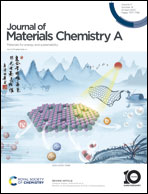Single transition metal atom centered clusters activating semiconductor surface lattice atoms for efficient solar fuel production†
Abstract
Surface activations are indispensable for photocatalysts to achieve high efficiency in solar fuel production, but the rational regulation of surface catalytic properties has been making slow progress, because of the limited knowledge about the atomic scale structure as well as the corresponding structure–property relations. Here we report the decoration of single transition metal atom centered clusters with an atomic configuration of Ni3+(OH)3(H2O)3via Ni–O–Zn bond linkages onto sulphide photocatalysts by using a general low concentration metal salt solution solvothermal strategy, which not only promotes the separation of charge carriers, but also lowers the kinetic energy barrier of water molecule dissociation, thereby leading to a 68% increase in the hydrogen production rate at a Ni loading amount of merely 0.05 wt%. The decorated clusters are found to bring shallow energy levels into the forbidden band, greatly promoting the separation of charge carriers. Moreover, they do not act as the reaction sites for hydrogen production, but function as activators, which change the electronic structures of neighboring surface lattice atoms, decrease the kinetic barrier of the water molecule dissociation step, eventually making the semiconductor surface more active for hydrogen production. These findings greatly advance the knowledge about the strategies for semiconductor surface activation, and will provide important guidance for the rational design of efficient photocatalytic systems in future.



 Please wait while we load your content...
Please wait while we load your content...